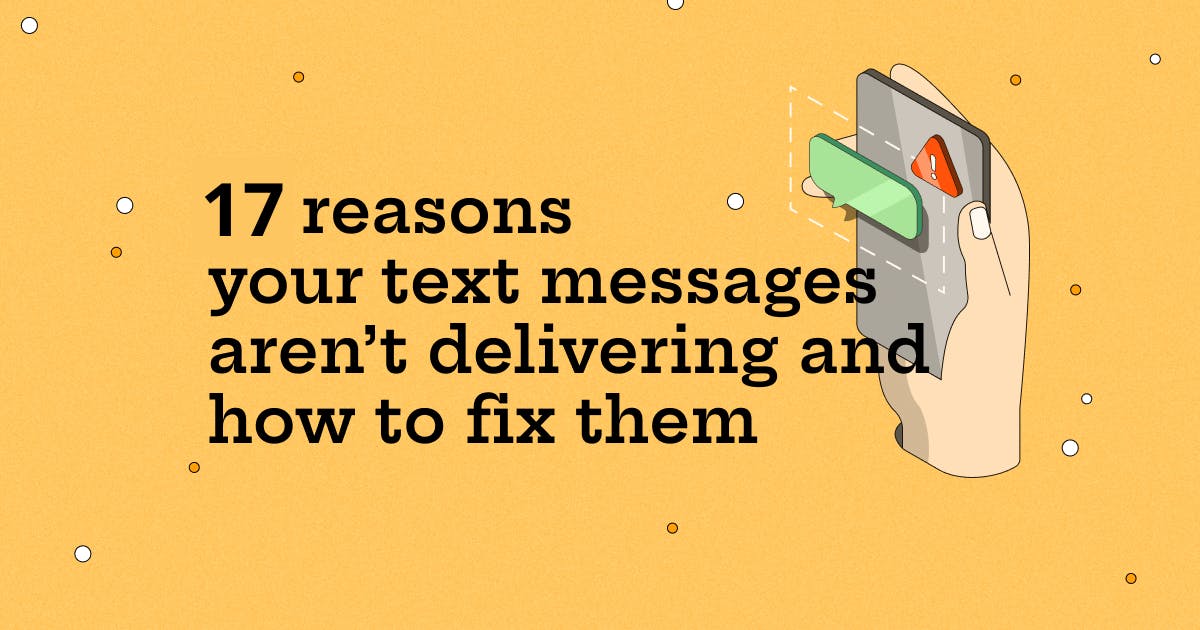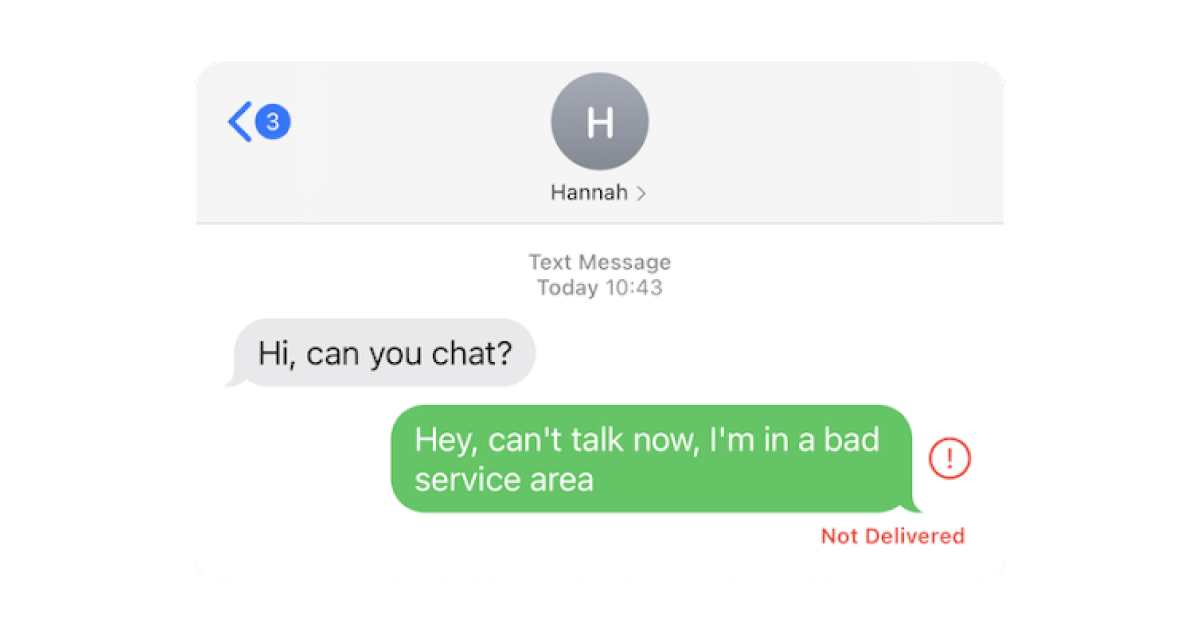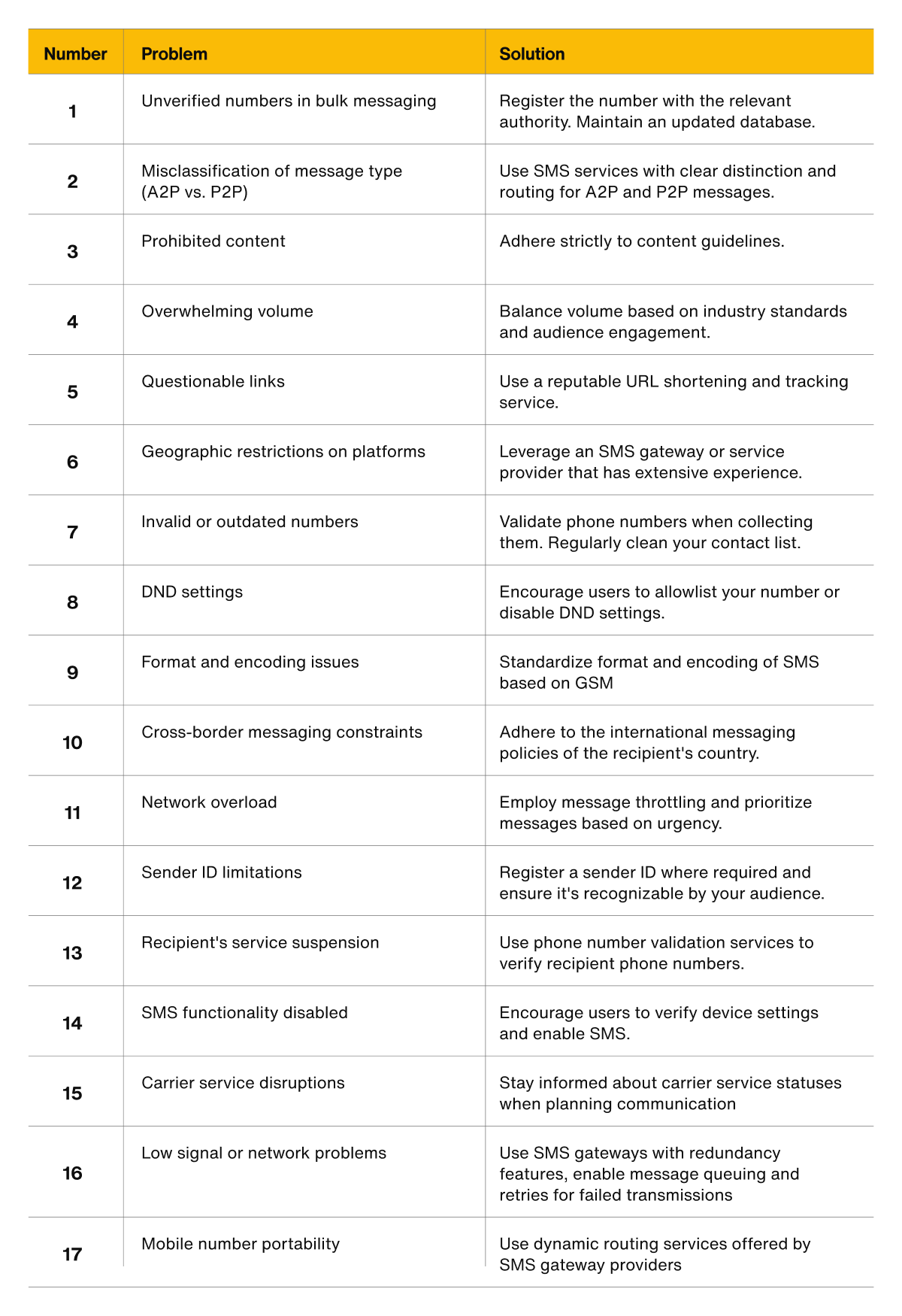17 reasons your text message failed to send and how to fix them

Fixing text message errors
When you're sending business messages to your users, encountering notifications like “Text message failed to send.”, or “Message was not delivered.” can be frustrating, especially when you’re unsure of the cause. If you’re asking yourself, “Why are my messages not delivering?”, it can be helpful to examine the causes of text message errors and how to fix them.
This guide aims to unravel the mystery behind text messages not delivering, examining possible causes and actionable solutions. We'll also understand how an SMS API can help you fix text message errors. Let's dive in!

Discover the unexpected costs of SMS & the savings of omnichannel messaging
Why is my message not delivering? 17 causes of text message errors (with solutions)
Here are the highlights of some reasons for text message errors, and how to fix them.

1. Unverified numbers in bulk messaging
Problem:
Carriers mandate verification for numbers used in mass texting to prevent misuse. Remember that unverified numbers—not authenticated or recognized by the network—can be flagged as potential spam sources, resulting in message blocking or failure to deliver.
Additionally, databases of contacts containing customer or user phone numbers can become outdated, with numbers being disconnected or transferred to new users who have not consented to receive messages.
Solutions:
- Register your number with the relevant authority, such as The Campaign Registry, and ensure compliance with carrier requirements.
- Maintaining an updated database through regular clean-up processes to remove or update inactive or invalid numbers can enhance SMS delivery success rates.
2. Misclassification of message type
Problem:
Using a personal number for bulk messages can lead to carrier filtering due to the distinction between peer-to-peer (P2P) and application-to-person (A2P) messaging. P2P messages are sent between individuals, and A2P messages are sent from businesses to individuals. A2P messaging typically requires different routing and regulatory handling compared to P2P messages. Carriers often apply distinct policies and charges for A2P messages due to their bulk nature and potential for spam. Misclassified messages may be blocked or fail to deliver.
Solutions:
- To address this, businesses should use SMS services (or an SMS API) that offer clear distinction and proper routing for A2P and P2P messages.
- Employing dedicated shortcodes or alphanumeric sender IDs for A2P messages can help in this classification, as these formats are typically reserved for business use and are pre-registered with carriers to comply with regulations.
3. Prohibited content
Problem:
Carriers automatically block messages containing or implying illegal activities or adult content. In some cases, carriers may block the message and the sender.
Solutions:
- Adhere strictly to content guidelines, avoiding any material likely to be construed as inappropriate or illegal.
- To test if the message has been blocked, send a simple hello. If this message is delivered, the carrier likely blocked your earlier message. In other words, the message has been blocked, not the sender.
4. Overwhelming volume
Problem:
Sending excessive P2P messages can trigger spam filters, leading to blocked delivery.
Solution:
- Balance your messaging frequency based on industry standards and audience engagement levels.

8 major support hassles solved with AI agents
5. Questionable links
Problem:
Carriers may filter messages containing untrustworthy links, including those shortened by third-party services. These filters scan messages for URLs that are associated with phishing, malware, or have been reported for suspicious activities, leading to the blocking or filtering of the SMS. Including a link in an SMS increases the scrutiny of the message, as links are common vectors for cyber attacks.
Solutions:
- Use a reputable URL shortening and tracking service that is known for its security measures and is widely recognized as safe.
- Maintain consistent sending behavior and use a domain that is clearly associated with your brand. This can help build trust with messaging platforms and recipients.
6. Geographic restrictions on platforms
Problem:
Geographic restrictions on platforms often lead to the non-delivery of SMS messages due to regulatory, legal, and operational constraints that vary by country. These restrictions can include limitations on the type of content that can be sent, the requirement for sender identification, or prohibitions on unsolicited messaging. Carriers and messaging services enforce these rules to comply with local regulations, which can block or filter SMS messages that do not adhere to the specific guidelines of the recipient's country.
Solution:
- Leverage an SMS API or service provider that has extensive experience and established relationships with carriers across different regions. This will help you navigate the landscape of international SMS regulations and can ensure compliance through proper message formatting, sender ID registration, and adherence to consent laws. Understanding and respecting the local regulations of each target country is crucial.
7. Invalid or outdated numbers
Problem:
A contact list with incorrect or deactivated numbers can signal to carriers a lack of diligence in maintaining subscriber consent. This contributes significantly to text messages not being delivered, and also wastes resources and skews marketing analytics with inaccurate information.
Solutions:
- Employ phone number validation services at the point of collection to immediately verify the format and existence of a number. These services can check numbers against current operator databases to confirm their validity.
- Regularly clean your contact list to remove invalid numbers, utilizing list verification tools if available. This process can be automated with software tools that periodically validate the phone numbers in your database.
8. Do Not Disturb (DND) settings
Problem:
Do Not Disturb (DND) settings block unsolicited communications, including SMS messages from businesses and marketing campaigns. When a user's number is on a DND list, messages sent to that number are either blocked entirely or filtered into a space the user checks less frequently, significantly affecting delivery rates and engagement.
Solutions:
- Encourage users to allowlist your number or disable DND settings for essential communications.
- For critical communications that must bypass DND restrictions, businesses can explore registering for transactional SMS services. These services are typically exempt from DND filters because they are used to send necessary information, such as bank alerts or appointment reminders, rather than promotional content.
9. Format and encoding issues
Problem:
Format and encoding issues in SMS messaging can lead to non-delivery or incorrect display of messages, as different mobile networks and devices may support various character sets and encoding standards. For instance, the use of standard GSM encoding supports 160 characters, but switching to Unicode to accommodate special characters or emojis implies that more data is used, so this reduces the limit to 70 characters. Misalignment with these standards can cause messages to be fragmented, garbled, or not delivered at all.
Solutions:
- Ensure your messages comply with the encoding and format standards of the target region or carrier. Businesses should standardize the format and encoding of their SMS messages based on the most widely supported standards, primarily GSM encoding.
- When sending messages that require special characters or languages outside the GSM character set, it's crucial to test message delivery across different devices and networks to ensure compatibility.
10. Cross-border messaging constraints
Problem:
International messaging may face additional hurdles due to varying regulations and carrier policies. Cross-border text messaging constraints, which encompass regulatory, technical, and operational challenges, can significantly impact the delivery of SMS messages across countries. Regulatory issues include varying data protection laws and consent requirements, while technical barriers may involve differences in network protocols and carrier technologies. Additionally, operational challenges such as message routing and partnerships with local carriers can affect SMS deliverability.
Solutions:
- Familiarize yourself with and adhere to the international messaging policies of the recipient's country.
- Partner with global SMS gateway providers that have established relationships with carriers worldwide and have expertise in navigating international regulations. These providers help you ensure compliance with country-specific laws and technical standards. You can also use an SMS API that may help to streamline this.

Reinvent CX with AI agents
11. Network overload
Problem:
High network traffic can delay or prevent message delivery. Network overload occurs when the volume of SMS traffic exceeds the carrying capacity of a mobile network, leading to delays or failures in message delivery. This can be especially prevalent during peak times or events that prompt mass communication, such as festive seasons. Such congestion results in the network's inability to process all messages efficiently, causing some to be delayed or lost.
Solutions:
- Monitor carrier notifications for the best sending times and avoid sending messages during peak hours.
- Employ SMS delivery optimization techniques such as message throttling, which involves spreading the dispatch of bulk messages over a longer period to avoid sudden spikes in demand.
- Prioritize messages based on urgency or importance to ensure that critical communications are delivered promptly (you can use an SMS API to do this).
- Use multiple carriers or routes for SMS delivery can also distribute the load more evenly.
12. Sender ID limitations
Problem:
Sender ID limitations refer to restrictions on the alphanumeric sender name that appears on the recipient's device. These can cause SMS non-delivery in certain regions due to regulatory or carrier-specific rules. These limitations may include the length of the sender ID, the use of non-alphanumeric characters, or outright bans on custom sender IDs to prevent fraud. For instance, some countries require pre-registration and approval of sender IDs to combat spam and phishing attempts.
Solutions:
- Businesses should familiarize themselves with their target markets' sender ID regulations. Utilizing an SMS gateway provider that offers expertise in global SMS regulations can simplify this process. These providers can assist in registering Sender IDs where required and advise on acceptable formats.
- Register your sender ID where required and ensure it's recognizable and trusted by your audience.
13. Recipient's service suspension
Problem:
If the recipient's service is suspended due to billing issues, the user switching carriers without porting their number, or other administrative reasons, the recipient won't receive messages.
Solutions:
- Implement a process for regularly verifying the status of recipient phone numbers, especially before dispatching critical or time-sensitive messages. Use phone number validation services to help identify numbers that are inactive or suspended.
- Employ fallback mechanisms, such as email or in-app messaging, to ensure that the communication reaches the intended recipient through an alternate channel.
14. SMS functionality disabled
Problem:
Some users may inadvertently disable SMS functionality on their devices, or network issues may prevent SMS delivery. This could be due to a variety of reasons, including privacy preferences, device restrictions, or technical malfunctions.
Solutions:
- Encourage users to verify device settings and enable SMS to receive critical communications. Providing clear instructions on how to check and enable SMS settings can assist users in resolving this issue themselves.
- Implement an omnichannel communication strategy. By offering alternatives such as in-app notifications, push notifications through an app, or messaging platforms (e.x., WhatsApp), businesses can ensure that critical information reaches their audience even when SMS is not a viable option.

Save big on SMS with in-app messages. Try the instant cost calculator today!
15. Carrier service disruptions
Problem:
Occasionally, technical issues with a carrier can affect SMS delivery. Carrier service disruptions resulting from technical failures, maintenance activities, or network overload can lead to the non-delivery of SMS messages. Such disruptions may affect a localized area or a broader network, impacting messages' timely and successful delivery. These issues are external to senders and recipients, making them challenging to predict or immediately resolve.
Solutions:
- Stay informed about carrier service statuses and plan your communication strategy accordingly.
- Implement an omnichannel communication strategy to ensure that critical messages reach recipients through alternative means, such as WhatsApp, push notifications, or in-app notifications, in the event of SMS delivery issues.
16. Low signal or network problems and network settings
Problem:
When a mobile device is in an area with poor reception or experiencing network congestion, it may struggle to establish a stable connection to the cellular network. As a result, SMS messages may fail to be sent or experience delays in delivery. Several factors contribute to low signal or network connection problems, including geographical obstacles such as tall buildings, mountains, or rural areas with sparse network coverage. Additionally, network congestion during peak hours or in densely populated areas can overload cellular towers, leading to delays or failures in message transmission.
Solution:
- Businesses can ensure text message delivery in low signal or network conditions by leveraging SMS gateways (or perhaps an SMS API, depending on your requirements) with redundancy features, enabling message queuing and retries for failed transmissions, offering Wi-Fi calling support for alternative connectivity, implementing offline message storage on users' devices, and utilizing intelligent message routing algorithms to select the most reliable network paths. It’s also important to ensure that alternative channels of communication, such as WhatsApp, push notifications, or in-app notifications.
17. Mobile number portability
Problem:
Mobile number portability (MNP) allows users to retain their mobile phone numbers when switching carriers. While beneficial for consumers, MNP can introduce issues in SMS delivery, particularly when databases used by SMS service providers are not updated to reflect the change in carrier. This misalignment can send messages through the original carrier's network, resulting in non-delivery if the number has been ported to a new carrier.
Solutions:
- Use dynamic routing services offered by SMS gateway providers. These services regularly update carrier information, ensuring messages are routed through the correct network irrespective of number portability.
- Additionally, employing Number Portability Lookup (NPL) services before sending bulk SMS can identify the current carrier of a mobile number, allowing for accurate routing and delivery.
- Ensure you have a fallback communication channel in place (such as in-app notifications, push notifications, or WhatsApp) in cases where the message is not delivered.

Delight customers with AI customer service
Use an SMS API as part of a mobile omnichannel business messaging solution when your message is not delivered
If you receive an error message like “Message is not delivered.” or “Text message failed to send.”, you now know why your text messages are not delivered.
To solve this problem, regardless of the cause, ensure that you have a fallback communication method such as WhatsApp, push notifications, or in-app notifications. You can set this up with Sendbird Business Messaging and empower all teams in your organization to send critical messages via the channel you see fit. For example, you might also look into the benefits and differences of SMS vs. MMS texting.
Deliverability has never been more important—especially now that AI customer service can be delivered over SMS. For proactive and omnipresent support, your AI agent needs an omnichannel strategy that includes SMS, push, in-app, email, and more. If you haven’t experienced AI customer service via SMS, try our SMS AI agent demo.
Omnichannel customer engagement and support is essential.
Whether you’re automating notifications or AI agent support for marketing, sales, operations, or support, we’ve got you covered. 👉 contact us








